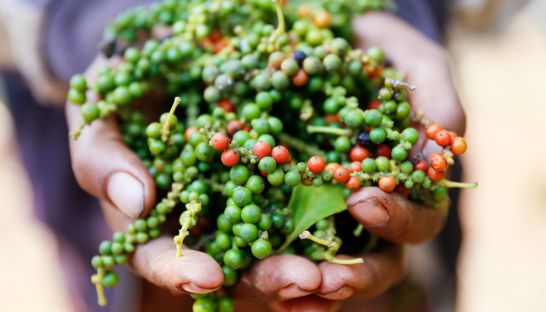Pepper sector shaken by boom
Pepper sector shaken by boom
The traditional supply chain dynamics for the renowned Kampot pepper are breaking down due to a market boom that has brought large-scale investment into pepper cultivation, while sidelining the small shareholders that rely on the benefits of being part of the association that represents them.

Ngoun Lay, president of the Kampot Pepper Promotion Association (KPPA), said that while the annual harvest is typically over by August with the product packaged and sold, about 30 tonnes of peppercorns remain stockpiled due to the increase in production. The increased harvest has put pressure on the association as larger producers have taken priority over their own orders.
“This is the first time that our peppercorns have been left stockpiled,” he said. “Normally, our stock is already finished by this time of the year.”
He explained that the problem wasn’t a lack of demand or the cost of the product.
“The KPPA’s issue is with local packagers who package their own products first,” he said, adding that the association has only sold 45 tonnes of its 80 tonne harvest this year to international markets.
The organisation, which represents 387 farmers, has partnered with 21 local packaging and exporting companies, which have harvested over 100 hectares this season.
Lay explained that because Kampot pepper has the World Trade Organization’s coveted Geographical Indication status, a growing number of companies within KPPA have taken advantage of its reputation by breaking away from the association’s norms by investing in their own packaging lines.
“We have never been concerned with local packagers before,” he said. “Now we realise this is our point of weakness, and we have to look for new partners for packaging and exporting our products.”
Bith Samoeurn, a small-scale farmer and member of the association, said he had collected 700 kilos of pepper from his half-hectare farm this year. However, he said that KPPA needed to find new packaging partners for him to be encouraged to sell at favourable prices.
“Normally I have sold my entire harvest by June,” he said. “This is the first time that I haven’t been able to sell by August.”
While he has managed to sell 40 kilos of red pepper to KPPA, he said he will wait until he has guarantees that the association can provide the highest value.
The price of Kampot pepper remains at $15 per kilo for black pepper, $25 per kilo for red pepper, and $28 per kilo for white pepper. This sector generates approximately $1 million in revenue annually, according to KPPA.
Hym Piseth, production director for local specialty food producer Confirel Co Ltd, agreed that there have been delays in purchasing pepper from KPPA as the company waits to finish securing orders for its own harvest first.
“We know the KPPA is disappointed in us, but we are a business and logically we need to be concerned with our own profits first,” he said. “That doesn’t mean that we have stopped buying from KPPA.”
He added that even if KPPA members find new export and packaging partners, it would not disrupt the company’s existing production chain. Instead, he said that KPPA was to blame for continuously allowing new members to join without securing its own supply chain.
Commerce Ministry spokeswoman Soeng Sophary said yesterday that the government would not intervene on KPPA’s behalf, adding that the association had to choose its private sector partners carefully to make sure that its interests were protected.
“Kampot pepper is already well-known in the market and it is not difficult for the KPPA to seek new partners,” she said. “The ministry cannot interfere with the private sector, it is the free market, and the association should be smart enough to prepare a strategy to protect its interests.”


